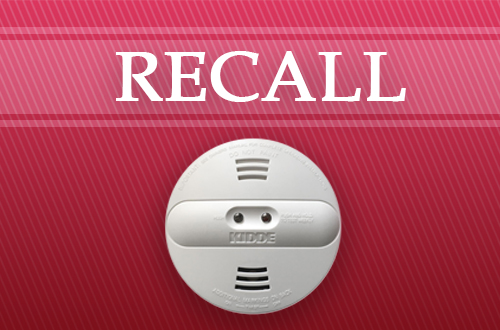Smoke Alarm Recall for 452,000 Units
March 22, 2018
Smoke alarms are an important part of a home fire escape plan. They help keep people safe and reduce home insurance claims by alerting you of smoke/fire with extreme immediacy. Last week a major recall alert was placed for 452,000 Kidde Dual Sensor Smoke Alarms due to risk of failure to alert consumers to a fire.
SUMMARY:
Kidde dual-sensor (photoelectric and ionization) smoke alarms – models PI2010 and PI9010
HAZARD:
A yellow cap left on during the manufacturing process can cover one of the two smoke sensors and compromise the smoke alarm’s ability to detect smoke, posing a risk of consumers not being alerted to a fire in their home.
REMEDY:
Replace. Consumers should remove the alarm from the wall/ceiling and visually inspect it through the opening on the side of the alarm for the presence of a yellow cap. Consumers should not attempt to take apart the alarm, open the casing, or otherwise remove the yellow cap themselves. If a yellow cap is present, the consumer should immediately contact Kidde to receive instructions and request a free replacement smoke alarm. They should remove and discard the recalled smoke alarm only after they receive and install the replacement alarm. If no yellow cap is present, consumers should reinstall the smoke alarm and no further action is needed.
CONSUMER CONTACT:
Kidde toll-free at 833-551-7739 from 8:30 a.m. to 5 p.m. ET Monday through Friday, from 9 a.m. to 3 p.m. on Saturday and Sunday, or online at www.kidde.com and click on “Product Safety Recall” for more information.
*From the U.S. Consumer Product Safety Commission
SMOKE ALARM TIPS:
- Replace all smoke alarms when they are 10 years old.
- A closed door may slow the spread of smoke, heat and fire. Install smoke alarms in every sleeping room and outside each separate sleeping area. Install alarms on every level of the home. Install alarms in the basement. Smoke alarms should be interconnected. When one sounds, they all sound.
- It is best to use interconnected smoke alarms. When one smoke alarm sounds they all sound.
- Test all smoke alarms at least once a month. Press the test button to be sure the alarm is working.
- Today’s smoke alarms will be more technologically advanced to respond to a multitude of fire conditions, yet mitigate false alarms.
- A smoke alarm should be on the ceiling or high on a wall. Keep smoke alarms away from the kitchen to reduce false alarms. They should be at least 10 feet (3 meters) from the stove.
- People who are hard-of-hearing or deaf can use special alarms. These alarms have strobe lights and bed shakers.
*From the National Fire Protection Agency (NFPA)

